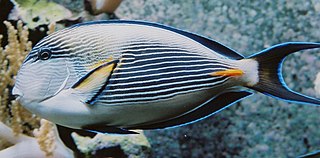
Acanthuridae are a family of ray-finned fish which includes surgeonfishes, tangs, and unicornfishes. The family includes about 86 extant species of marine fish living in tropical seas, usually around coral reefs. Many of the species are brightly colored and popular in aquaria.

The Lacertidae are the family of the wall lizards, true lizards, or sometimes simply lacertas, which are native to Afro-Eurasia. It is a diverse family with at about 360 species in 39 genera. They represent the dominant group of reptiles found in Europe.

The cobia is a species of marine carangiform ray-finned fish, the only extant representative of the genus Rachycentron and the family Rachycentridae. Its other common names include black kingfish, black salmon, ling, lemonfish, crabeater, prodigal son, codfish, and black bonito.
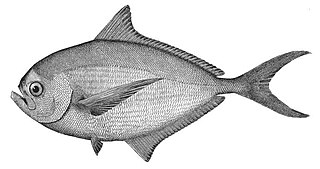
Pomfrets are scombriform fish belonging to the family Bramidae. The family currently includes 20 species across seven genera. Several species are important food sources for humans, especially Brama brama in South Asia. The earlier form of the pomfret's name was "pamflet", a word which probably ultimately comes from Portuguese pampo, referring to various fish such as the blue butterfish. The fish meat is white in color.

Melanosuchus is a genus of caiman. The genus is most commonly referred to as the "Black Caimans". The black caiman of South America is the sole extant (living) species, and is the largest living member of the subfamily Caimaninae, as well as the entire alligator family Alligatoridae.

Leftvents are a family, the Linophrynidae, of marine ray-finned fishes which is classified within the suborder Ceratioidei, the deep sea anglerfishes. These fishes are found in the Atlantic, Indian and Pacific Oceans.

The ladyfish or tenpounder is a species of fish in the genus Elops, the only genus in the monotypic family Elopidae.

Sander is a genus of predatory ray-finned fish in the family Percidae, which also includes the perches, ruffes, and darters. They are also known as "pike-perch" because of their resemblance to fish in the unrelated Esocidae (pike) family. They are the only genus in the monotypic tribe Luciopercini, which is one of two tribes in the subfamily Luciopercinae.
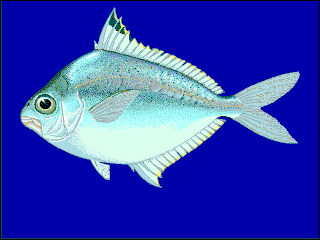
Leiognathidae, the ponyfishes, slipmouths or slimys / slimies, are a small family of fishes in the order Perciformes. They inhabit marine and brackish waters in the Indian and West Pacific Oceans. They can be used in the preparation of bagoong.
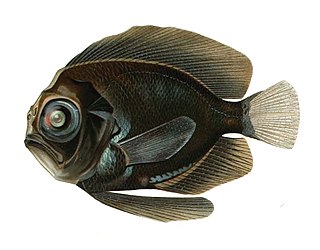
Caristiidae, the manefishes, are a family of scombriform ray-finned fishes which today includes 19 extant species distributed in four genera. Chalcidichthys malacapterygius and Absalomichthys velifer are extinct species in this family from the Upper Miocene of Southern California.

Gymnocephalus is a genus of ray-finned fishes from the family Percidae, which includes the perches, pike-perches and darters. They are from the Western Palearctic area, although one species, Gymnocephalus cernua has been accidentally introduced to the Great Lakes region where it is regarded as an invasive species. They have the common name "ruffe" and resemble the true perches in the genus Perca, but are usually smaller and have a different pattern.
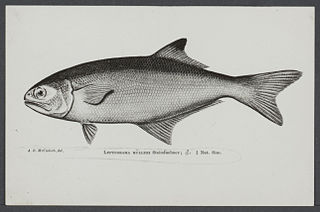
Leptobrama is a genus of ray-finned fish in the order Carangiformes found in the Pacific Ocean. This genus is the only member of the family Leptobramidae.
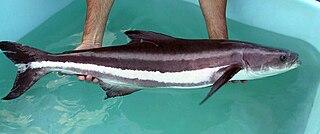
Cobia, a warm water fish, is one of the more suitable candidates for offshore aquaculture. Cobia are large pelagic fish, up to 2 metres (6.6 ft) long and 68 kilograms (150 lb) in weight. They are solitary fish except when spawning, found in warm-temperate to tropical waters.

Lateolabrax is a genus of commercially important ray-finned fishes known as the Asian seabasses. It is the only genus in the family Lateolabracidae. This genus is native to the coastal waters of the western Pacific Ocean. This genus has also been included in family Moronidae and may be nested within the Polyprionidae.

Myllokunmingiidae is a group of very early, jawless prehistoric fish (Agnathans) which lived during the Cambrian period. The Myllokunmingiids are the earliest known group of craniates. The group contains only three known genera, Haikouichthys, Myllokunmingia, and Zhongjianichthys. Their fossils have been found only in the Maotianshan Shales lagerstätte.

Banjos is a genus of marine ray-finned fish, the only genus in the monotypic family Banjosidae, which is part of the order Acropomatiformes. They are native to the western Indian and the Atlantic coasts of Africa, and is made up of the three species of banjofishes.
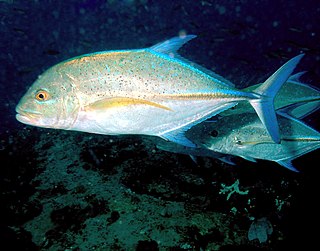
Carangiformes is an order of ray-finned fishes that is part of a sister clade to the Ovalentaria, the other orders in the clade being the Synbranchiformes, Anabantiformes, Istiophoriformes, and Pleuronectiformes. The Carangiformes have been long regarded as a monotypic order with only the family Carangidae within it by some authorities, and the other current families within the order have been previously classified as part of the wider order Perciformes. The 5th edition of Fishes of the World classify six families within Carangiformes, with other authorities expanding the order to include up to 30 families.

Sinipercidae, the Chinese perches or Oriental perches, is a family of freshwater ray-finned fishes, part of the order Centrarchiformes. They have been placed within the temperate perch family, Percichthyidae in the past but may be more closely allied to the Centrarchidae.
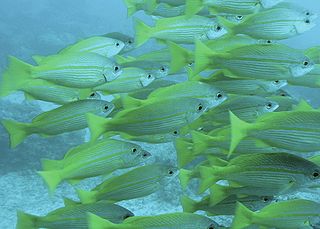
Lutjaninae is a subfamily of marine ray-finned fishes, one of four subfamilies classified within the family Lutjanidae, the snappers.



















